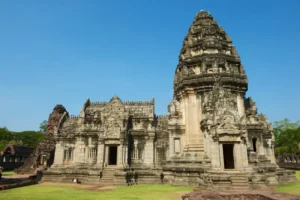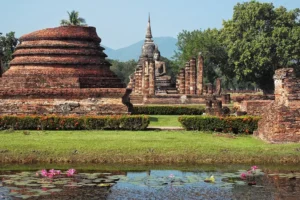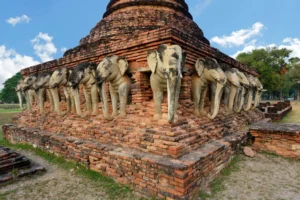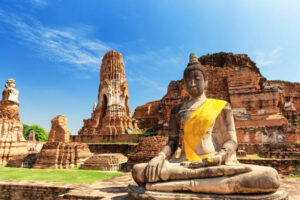
Clashes reignited on Thursday along the Thailand-Cambodia border, marking the most violent escalation in tensions between the two Southeast Asian nations in more than a decade. At the heart of the ongoing dispute lies a cluster of ancient Hindu temples—most notably the Preah Vihear and Ta Muen Thom temples—whose religious, cultural, and geopolitical significance continues to fuel deep-rooted hostilities.
A Shrine in the Clouds: Preah Vihear Temple
The focal point of the conflict is the 900-year-old Preah Vihear temple, a stunning Hindu shrine dedicated to Lord Shiva. Perched atop a 525-metre cliff in Cambodia’s Dangrek Mountains, Preah Vihear offers sweeping views of the plains below and has stood as a sacred site since the Khmer Empire. While the temple physically lies in Cambodia, it remains a symbol of cultural and historical importance to both Cambodians and Thais.
The temple, along with others in the region, has often been overshadowed by the globally renowned Angkor Wat. However, its strategic location and the murky history of border demarcations have made Preah Vihear a flashpoint in Cambodia–Thailand relations for more than half a century.
Renewed Violence Along the Border

The most recent round of hostilities erupted early Thursday morning near the Ta Muen Thom temple in Thailand’s Surin Province, about 95 km west of Preah Vihear. According to the Thai government, the skirmish began when Cambodian forces allegedly deployed drones for aerial surveillance near Thai military posts. Attempts by Thai troops to diffuse the situation reportedly failed, and by 8:20 AM local time, both sides were engaged in intense gunfire. Thailand stated it acted in self-defense after Cambodian units fired RPGs. In contrast, Cambodia accused Thailand of violating its sovereignty.
The exchange of fire left 12 soldiers dead and dozens wounded on both sides. Thailand subsequently raised its security threat level to “Level 4” and ordered a complete shutdown of all border checkpoints along the contested frontier. The violence forced the evacuation of more than 40,000 Thai civilians from 86 villages near the conflict zone.
Khmer Temples, Colonial Lines: Why Thailand and Cambodia Still Clash

The roots of the conflict lie in colonial-era border agreements dating back to when Cambodia was a French protectorate and Thailand was known as Siam. In 1907, French cartographers produced a map placing the Preah Vihear temple within Cambodian territory. Thailand initially accepted the map but later claimed that it had been misled, arguing the natural watershed should define the border.
In 1962, the International Court of Justice (ICJ) ruled in Cambodia’s favor, ordering Thailand to withdraw its troops and return any temple artifacts it had removed. The court based its decision on the French map and Thailand’s original acceptance of it.
After clashes flared up again in 2011, the ICJ clarified its earlier judgment in 2013, not only reaffirming Cambodian sovereignty over Preah Vihear but also granting it control over the surrounding areas. The ruling demanded that Thai forces withdraw from the region.
While Preah Vihear remains the most prominent site, recent clashes have centered around Ta Muen Thom—a 12th-century Shiva temple complex in the Dangrek Mountains. The site includes three temples: Ta Muen Thom, Ta Muen, and Ta Muen Tot. Unlike most Khmer temples, Ta Muen Thom’s sanctuary faces south rather than east, and it houses a naturally formed Shivling, making it a unique religious site.
The temple’s location on the heavily forested and disputed border has turned it into a persistent source of friction. In February 2025, a video went viral showing Cambodian soldiers singing their national anthem at the site, reportedly provoking a confrontation with Thai troops.
The broader issue reflects the complications left behind by colonial-era treaties. Between 1904 and 1907, France and Siam signed a series of agreements to formalize territorial boundaries. French cartographers often used watershed lines, but made exceptions near culturally sensitive landmarks like Preah Vihear. This has resulted in inconsistencies and disputes that modern mapping technology continues to reveal.

In 2008, Cambodia succeeded in getting Preah Vihear listed as a UNESCO World Heritage site, reigniting nationalist tensions in Thailand. The move led to political fallout, including the resignation of Thailand’s then Foreign Minister, Noppadon Pattama, and renewed military clashes that claimed lives on both sides.
Conclusion
As ancient temples continue to stir modern-day nationalism, the conflict between Cambodia and Thailand underscores how colonial legacies and contested heritage sites can remain dangerously unresolved. Despite international rulings, shifting geopolitics and deep-seated mistrust ensure that these sacred ruins remain at the Center of a modern geopolitical storm.
